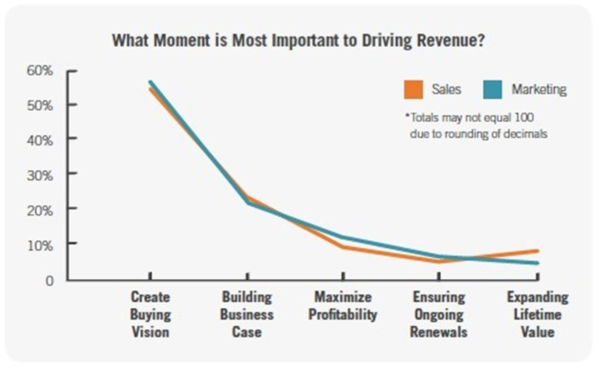LinkedIn Navigator is Only a Tool and Does Not Drive Sales & Revenue Opportunities
— August 3, 2018
Think about traditional email campaigns. Before LinkedIn, b2b firms used to buy “lead lists” to get contact info for prospecting. The conversion rate on these lists is less than 1%, which is why most experienced sales managers recommend against them.
Now, sales and marketing teams are using LinkedIn Navigator as lead lists and achieving the same 1% or less conversion. They may be expanding their networks and getting “likes,” but not closes and revenue.
Navigator finds people, not revenue opportunities….
Most experienced leaders describe how sales is a relationship game because it’s based on trust, and the fact that they all come to this conclusion is pretty telling in and of itself. Personal connections win, and this knowledge helps VPs and CXOs to screen incoming messages as “tells” of the relationship. Yet, when sales and marketing approach social media, they’re taking a volume based approach and forgetting that we need to make a personal connection to get senior buyer attention.
In speaking with the VPs of Sales at supply chain companies like CH Robinson and DHL, as well as technology companies like Oracle and RICOH, I’ve learned that sales teams are using LinkedIn Sales Navigator to build massive lists of prospects that they “think” they should reach out to in bulk, with template messaging, because they “may” need their services.
They are betting on “maybes,” pushing out content and messaging and trying to pull the leads in. However, sales shouldn’t be pushing or pulling as I mention in Buyers Should Be Pulling Sales Through the Buying Journey. Instead, we should focus our time and effort on creating real, personal, insightful social conversations with prospects, not leads.
A “lead” only becomes a “prospect” when Sales and Marketing can….
· Identify a differentiated value prop for a specific company (not just industry/region)
· Share specific commercial insight exposing previously unconsidered costs or risks
· Demonstrate your understanding of the buyers’ specific process gaps & impacts
· Help them think differently about how to solve their specific challenges
· Show the buyer how you’re different from specific competitors they’ll consider
· Provide emotionally charged stories with specific and personally relevant proof
· Quantify their specific pain, hard & soft costs, risk protection, or growth opportunity
Then, a “prospect” only becomes an “opportunity” when…
· We can “show, not tell” buyers that specific process gaps exist and are worth solving
· And the customer personally acknowledge their specific process gaps & impacts
This way your 1st conversation is on how you’ll close their gaps, rather than why they should consider a change. Following this approach from end-to-end also lets you continually accelerate by skipping unnecessary steps.
In short, treating prospects and opportunities like “leads” with a volume approach creates a win rate of 10% or less. Conversely, using a strategic approach to create trust through a personal connection ensures you touch only qualified opportunities with a reliable 50-70% chance of closing.
My grandfather told me years ago that haste makes waste, and it took me a good 30 years to figure out he was right. Sales, marketing and business development should not be using LinkedIn Sales Navigator until the right prospects have been identified. In More Leads Are Destroying Your Revenue Performance, you’ll see how taking the volume approach in haste creates unreliable results because the leads are not opportunities.
With the volume approach, it’s like we’re all so excited to go to the beach that we get in the car and forget our swim trunks!
Here are 6 ways Sales & Marketing can work together before using LinkedIn Navigator to target “opportunities” instead of “leads,” creating a 50%+ win rate on their top targets with a repeatable process:
1. Farm your existing account opportunities.
It’s not possible to segment leads, prospects, and opportunities until we understand where we win and where we lose. By going internal before external, marketing is able to create case studies & personal branding for sales leadership based on your past successes and target markets. More importantly, marketing can take the opportunity to uncover what value the client is receiving, what value they are missing, and what value the sales team is missing which can be used to increase margins or up-sell.
Per CMO.com, sales support falls off after the “buying vision” is created. Therefore, it’s a great opportunity for you to differentiate from your competitors. This is how regional 3PL’s and WMS firms edge out large networks like Ryder to earn awards from targeted fortune 25 manufacturers.
Because marketing is creating penetration opportunities that were out of reach for the past 3 years, the same approach is now being taken to expand revenue and margins with targeted distributors and channel partners.
2. Investigate your current LinkedIn connections.
Only after being armed with the knowledge of what our customers like about our service and what they don’t, we can now segment leads/prospects/opportunities and craft unique messaging for each showing our personal relevance to their needs.
Over the past decade, most executives and sales reps have accumulated hundreds or thousands of “dead” LinkedIn connections. They are referred to as dead because there’s been no engagement, and there’s been no engagement because the prospect couldn’t find their personal value if they were previously handled like a “lead.”
By re-engaging dead connections who did not respond to previous template/volume-based outreach, national companies like Schneider Logistics (TMS) have qualified – and won – multiple $ 500k opportunities. These went on to produce 6-9 month sales cycles rather than the previous 12-18 standard by avoiding unnecessary procedures.
3. Focus on your NAMED, targeted accounts.
Similar to how marketing should qualify prospects based on proven success, sales should also qualify the accounts that are most desirable to them. This guarantees absolutely that 100% of marketing’s time and budget are invested exclusively where Sales wants to progress. Sales can prove revenue through close rate and deal size, this gives the Marketing manager influence past “clicks and likes.”
Profiles, case studies, and personal messaging should be purpose-built for the named target accounts, which is how a 3-year old Los Angeles-based software firm contacted the CFO of GE Healthcare to replace Oracle as their order management platform. This prospect would be considered unreachable for any other start-up company, and the targeted approach has been used elsewhere to reverse a “no” into a “yes” for large awards like UPS and Agility.
4. Identify your similar opportunities.
When a concern, challenge or opportunity is discovered from a client or prospect, Marketing can research accounts which match their profile who are highly likely to have a similar challenge.
For example, when completing voice of the customer research for a 3PL serving manufacturing companies, we learned that a CPG manufacturer had a strong concern about the “On-Time, In Full Initiative” Walmart was implementing. They’ll be squeezing the profit margins of manufacturers by 3% if not able to maintain an 85% OTIF score, and we found their clients had scored as low as 10!
From this new view, we were able to identify other CPG companies like Unilever with a similar supply chain structure and delivery network, which are highly likely to have the same challenges.
5. Monitor your industry trends.
It’s difficult for one person to be in two places at the same time. While Sales is off building relationships and working towards the close, Marketing can monitor news feeds weekly to watch for industry-related changes or disruptions. This is also one area where Marketing can tap into “BIG IDEA” themes, as customers like to be kept up to date about relevant news.
For example, when Walmart and Amazon make changes to their business requirements, that causes ripple effects into their networks and vendors. If you can show specific companies that may be impacted how to proactively resolve the upcoming challenges in ways your competitors don’t, you will spark an opportunity. In addition to the immediate active funnel success, the topic was repurposed for outbound marketing which earned 12 new contacts at 5 new prospect manufacturers within a week.
6. Heavily screen your inbound opportunities.
Inbound is not to be forgotten! The real question is how and why they came, and here I advise you to step with caution. Unfortunately, companies like CEB and Gartner have described that 70% of inbound leads will absorb a sales rep’s time even when they have no intent to buy. For this reason, inbound should be handled by Marketing and NOT given to Sales until qualified.
By intercepting the inbound and qualifying for pain points, budget and other factors before a call, you can disqualify questionable opportunities before Sales spends time on the phone. This way, you guard the team against bad meetings as well as helping them to produce good ones.
Building a repeatable 50-70% close rate requires tight Sales & Marketing alignment.
With these processes in place, you’ll now have full scuba gear rather than forgotten trunks. By identifying prospects and opportunities versus leads, while using custom content to fuel personalized conversations, you create a direct connection between Marketing and ROI driving up close rate & deal size.
This is why Sales & Marketing need to work together to uncover the opportunities BEFORE diving into LinkedIn Navigator because we need the right stories, content, and messaging aligned with our personal brand and named targets to get past the 10% hump.
—
To see examples of targeted vs template profiles and content, you’re also welcomed to join my Beyond Lead Gen community.
Digital & Social Articles on Business 2 Community
(62)




